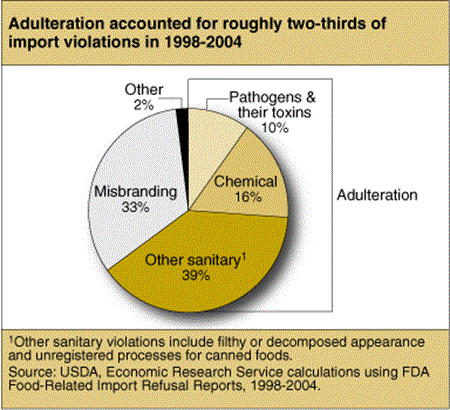Adulteration Accounts for Majority of FDA Food-Related Import Refusals

Imported foods, particularly perishable, minimally processed foods, are a growing part of the American diet. Yet several high-profile international food safety scares have drawn attention to the safety of some imported foods. Determining the extent of the risks is difficult because data limitations constrain what is known about the safety of imported foods. As a first step to understanding this issue better, ERS researchers analyzed U.S. Food and Drug Administration (FDA) data on food import shipments that were refused entry into the U.S. during 1998-2004, by type of food and by type of violation. The presence of a violation does not necessarily mean that a food was unsafe. Some of the violations, such as for unregistered processes and labeling, may not imply food safety risks.
FDA does not have the resources to examine every shipment of food entering the country. Instead, FDA relies on risk-based criteria to guide its actions, including past histories of violations with products and/or importers. Because FDA selects only a portion of shipments for inspection or other administrative actions at random, the ERS analysis cannot estimate the level or distribution of actual food safety risk that imports may pose to American consumers. The study, however, does reveal recurring risks and other problems in certain types of imported foods.
Of the 70,369 import violations in 1998-2004, 65 percent were for adulteration, 33 percent were for misbranding, and 2 percent were for “other violations,” such as items forbidden or restricted in sale. Adulteration involves product safety, package integrity, or sanitation. The import refusal data indicate that the most common adulteration violations were for the appearance of filth in a food product and for failure to file information or register a specified process. Salmonella accounted for 63 percent of pathogen violations, while unsafe coloring was the most common (46 percent) chemical contamination violation. Misbranding occurred when the article’s labeling failed to bear the required nutritional information, did not list the common name for each ingredient, or was not written in English. Fruit and fruit products accounted for the highest number of misbranding violations. One example is a prune jam label that failed to bear the required saccharin warning statement.
The three imported food categories with the most violations were vegetables (20.6 percent of total violations), fishery and seafood (20.1 percent), and fruit (11.7 percent). Import refusals for sanitary violations in seafood and fruit products, pesticide violations in vegetables, and unregistered processes for canned food products in these three categories were persistent over time.
Food Safety and Imports: An Analysis of FDA Import Refusal Reports, by Jean C. Buzby, Laurian Unnevehr, and Donna Roberts, USDA, Economic Research Service, September 2008


